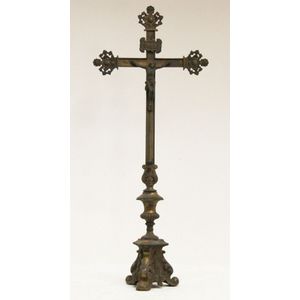Oak Hall Stand with Barley Twist and Eight Hooks
You must be a subscriber, and be logged in to view price and dealer details.
Subscribe Now to view actual auction price for this item
When you subscribe, you have the option of setting the currency in which to display prices to $Au, $US, $NZ or Stg.
- Edwardian - The Edwardian period of English furniture and decorative arts design is named for Edward VII (1841 ? 1910) who was King of the United Kingdom and the British Dominions and Emperor of India for the brief period from 1901 until his death in 1910. It follows the Victorian period, in turn was followed by the Art Nouveau and Art Deco styles. In Australia, designs of this period are also known as being in the Federation style.
- Oak - Native to Europe and England, oak has been used for joinery, furniture and building since the beginning of the medieval civilisation. It is a pale yellow in colour when freshly cut and darkens with age to a mid brown colour.
Oak as a furniture timber was superceded by walnut in the 17th century, and in the 18th century by mahogany,
Semi-fossilised bog oak is black in colour, and is found in peat bogs where the trees have fallen and been preserved from decay by the bog. It is used for jewellery and small carved trinkets.
Pollard oak is taken from an oak that has been regularly pollarded, that is the upper branches have been removed at the top of the trunk, result that new branches would appear, and over time the top would become ball-like. . When harvested and sawn, the timber displays a continuous surface of knotty circles. The timber was scarce and expensive and was used in more expensive pieces of furniture in the Regency and Victorian periods. - Barley Twist - The leg, and frequently other uprights such as columns, chair frames, spindles and stretchers, are turned in fairly wide and deep spirals, usually slightly rounded. Also known as the 'Jacobean twist' and common on the dark stained Jacobean Revival furniture of the 1930s and 40s.
As a rule, the twists on opposite uprights should move in a contrary direction. Thus, if the spiral on a right side is clockwise, that on the left side should move in a counter-clockwise direction.
This is also true of rope-twist or cable-twist turning, a nautical term that came into fashion after Nelson's victories over the French fleet. The essential difference is that with rope twists, the spirals are more finely turned on the lathe and placed closer together, than they are with barley-sugar turnings.
This item has been included into following indexes:
Visually similar items

Gilt metal standard lamp on quatrefoil base, 156 cm height, requires rewiring

A late 19th century ecclesiastical crucifix on a triform base. 80 cm high.

A Victorian mahogany four branch hall stand with eight turned coat pegs, central flap-top compartment and a pair of umbrella stands with original drip trays. Height 186 cm

A lady's Revue 9ct white gold wrist watch; square dial with synthetic blue sapphire set lugs to metal band.
